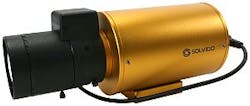Videor SLC-100P camera has extended dynamic range
PRESS RELEASE
High demands are made on the camera technology used for monitoring automated welding procedures due to extremely bright light. The new SLC-100P camera from the Videor Solvido range, which is fitted with the patented Digital Pixel System technology (DPS), is the ideal solution for clear, high-contrast pictures, even under these conditions.
During automated welding it is important to constantly monitor the procedure in order to be able to immediately intervene in the event of errors and to avoid waste. High demands are made on the camera technology used for monitoring automated welding procedures. Apart from the harsh industrial environment, which means the camera needs a sturdy casing, the greatest demand is the extremely bright light that almost dazzles the camera and blurs the video image in a white beam of light.
The new SLC-100P was particularly developed for such applications. It has a sturdy aluminium casing and a Pixim DPS sensor, which takes outstanding pictures in environments with extremely bright sources of light and strong contrasts. The Digital Pixel System technology (DPS) developed and patented by the American company, Pixim and Stanford University organises 388,800 pixels to act as a continuous self-regulating, individual camera. Contrary to conventional camera technology, which only digitizes pictures after a series of processing operations, with the DPS technology the image is digitized immediately thanks to the integration of an A/D converter (analogue to digital) on each individual pixel of the sensor. Thus the chip can assign an optimal exposure time to each individual pixel. This significantly extends the dynamic range of the camera currently measured at 120dB.
Therefore, the SLC-100P is ideally suitable for recording under extreme light conditions, as is the case with welding procedures. Further advantages of this technology are: little Blooming (blooming is a bright pixel produced by a load overflow into the neighbouring pixels, which appear as bright marks on the screen) and no Smear Effect. For example seen as the highlight caused by bright light spots, which turn into visible streaks in the image.
SOURCE: Videor
-- Posted by Vision Systems Design
